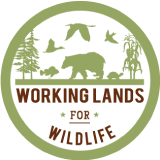NRCS Conservation Practices and Materials
New Frameworks Guide Conservation Action
WASHINGTON, April 6, 2021 – The U.S. Department of Agriculture (USDA) is unveiling new action-based frameworks to increase conservation work to address threats facing America’s working rangelands. These frameworks are designed to benefit both agriculture and wildlife in sagebrush and grassland landscapes of the western United States.
USDA Invests $28 Million in New Projects to Help Restore Lost Wetland Functions, Benefits on Agricultural Landscapes
WASHINGTON, March 15, 2021 – The U.S. Department of Agriculture (USDA) is investing $28 million in six new Wetland Reserve Enhancement Partnership (WREP) projects and four ongoing ones, which enable conservation partners and producers to work together to return critical wetland functions to agricultural landscapes. Partners will contribute $2.82 million, bringing the total investments to $30.82 million.
Rangeland Analysis Platform
The Rangeland Analysis Platform (RAP) is an interactive web application designed to assist in managing and monitoring America’s valuable rangelands. This free tool was developed for landowners, managers, and conservationists to quickly and easily access information that can guide land use decisions.
Upcoming Webinar: Introduction to the Southeast FireMap
A free webinar for practitioners and the public to learn about the Southeast FireMap with representatives from USDA-NRCS, Tall Timbers Research Station, the Longleaf Alliance, the Southern Fire Exchange, and the University of Florida.
Tip for Raising EQIP Payment Rate for Prescribed Burns
Potential approaches to raising payment rates for prescribed burns.
USDA Seeks Innovative Partner-led Projects Delivering Sustainable Agricultural Solutions
WASHINGTON, March 16, 2021 – The U.S. Department of Agriculture (USDA) is seeking proposals to fund up to $75 million in new, unique projects under the Regional Conservation Partnership Program’s (RCPP) Alternative Funding Arrangements (AFA) that take innovative and non-traditional approaches to conservation solutions at the local, regional and landscape scales. In making selections. USDA’s Natural Resources Conservation Service (NRCS) will prioritize projects related to climate smart agriculture and forestry.
A Natural Treasure: Florida's Sandhills & Grasslands
Learn how local and state partners with USDA’s Natural Resources Conservation Service have permanently protected a pristine sandhill grassland ecosystem in north-central Florida from rapidly advancing development.
SE FireMap
An improved system for mapping fires across the U.S.
Eastern Hellbender Structural Habitat Augmentation Guidance
This is a technical document to provide guidance on the installation of structural habitat for adult and juvenile Eastern Hellbenders. The document details spacing, placement, and specifications for in-stream nest and cover rocks.
SE FireMap Version 1.0 Data Use Agreement
This agreement document provides details on permitted uses, expectations and other conditions which may affect eligibility to download and utilize the data. Download and Submit this completed form to the following email: SEFireMap@talltimbers.org
SE FireMap Version 1.0 BETA Product Information
Learn more about the dataset development process, attribute descriptions, known issues, limitations, considerations, and references.
Map of NRCS States Opting In/Out of WLFW Northern bobwhite
In February 2021, NRCS requested that 30 state offices within the northern bobwhite current or historic range submit a final decision to National Headquarters on opting in or out of WLFW Northern bobwhite, Grasslands and Savannas. The decisions were completely voluntary and dependent on each states interest and ability to commit. These maps depict the distribution of states and their responses. Note that Oklahoma has now joined (and we need to updated this map)!
645 Covey Headquarters Planning Job Sheet (MO example)
645 Quail Covey Headquarters Planning example from Missouri NRCS





















